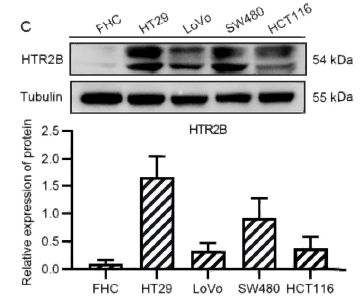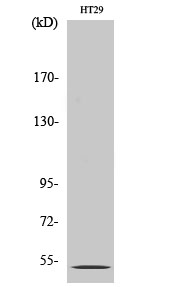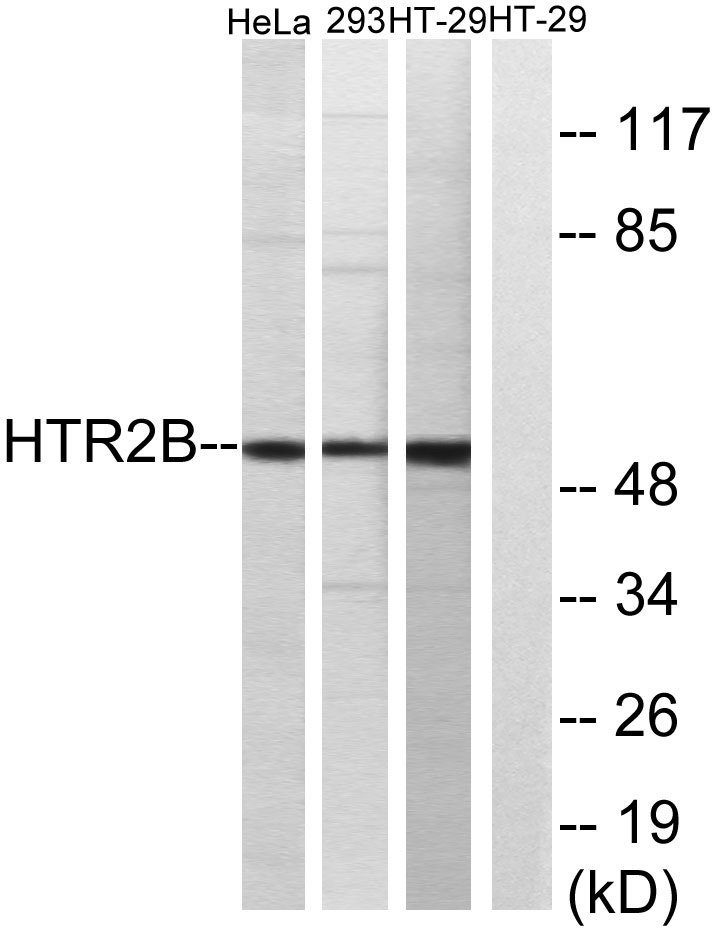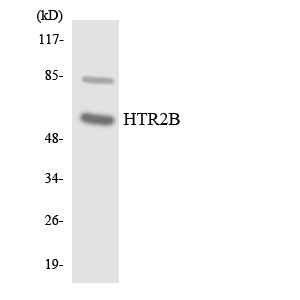SR-2B Polyclonal Antibody
- Catalog No.:YT4398
- Applications:WB;IF;ELISA
- Reactivity:Human
- Target:
- SR-2B
- Fields:
- >>Calcium signaling pathway;>>Neuroactive ligand-receptor interaction;>>Gap junction;>>Serotonergic synapse;>>Inflammatory mediator regulation of TRP channels
- Gene Name:
- HTR2B
- Protein Name:
- 5-hydroxytryptamine receptor 2B
- Human Gene Id:
- 3357
- Human Swiss Prot No:
- P41595
- Mouse Swiss Prot No:
- Q02152
- Immunogen:
- The antiserum was produced against synthesized peptide derived from human HTR2B. AA range:15-64
- Specificity:
- SR-2B Polyclonal Antibody detects endogenous levels of SR-2B protein.
- Formulation:
- Liquid in PBS containing 50% glycerol, 0.5% BSA and 0.02% sodium azide.
- Source:
- Polyclonal, Rabbit,IgG
- Dilution:
- WB 1:500 - 1:2000. IF 1:200 - 1:1000. ELISA: 1:10000. Not yet tested in other applications.
- Purification:
- The antibody was affinity-purified from rabbit antiserum by affinity-chromatography using epitope-specific immunogen.
- Concentration:
- 1 mg/ml
- Storage Stability:
- -15°C to -25°C/1 year(Do not lower than -25°C)
- Other Name:
- HTR2B;5-hydroxytryptamine receptor 2B;5-HT-2B;5-HT2B;Serotonin receptor 2B
- Observed Band(KD):
- 54kD
- Background:
- This gene encodes one of the several different receptors for 5-hydroxytryptamine (serotonin) that belongs to the G-protein coupled receptor 1 family. Serotonin is a biogenic hormone that functions as a neurotransmitter, a hormone, and a mitogen. Serotonin receptors mediate many of the central and peripheral physiologic functions of serotonin, including regulation of cardiovascular functions and impulsive behavior. Population and family-based analyses of a minor allele (glutamine-to-stop substitution, designated Q20*) which blocks expression of this protein, and knockout studies in mice, suggest a role for this gene in impulsivity. However, other factors, such as elevated testosterone levels, may also be involved. Alternatively spliced transcript variants have been found for this gene. [provided by RefSeq, Mar 2016],
- Function:
- function:This is one of the several different receptors for 5-hydroxytryptamine (serotonin), a biogenic hormone that functions as a neurotransmitter, a hormone, and a mitogen. This receptor mediates its action by association with G proteins that activate a phosphatidylinositol-calcium second messenger system.,similarity:Belongs to the G-protein coupled receptor 1 family.,subunit:Interacts with MPDZ.,tissue specificity:Detected in most peripheral organs. Only low expression levels were found in the brain.,
- Subcellular Location:
- Cell membrane ; Multi-pass membrane protein . Cell junction, synapse, synaptosome .
- Expression:
- Ubiquitous. Detected in liver, kidney, heart, pulmonary artery, and intestine. Detected at lower levels in blood, placenta and brain, especially in cerebellum, occipital cortex and frontal cortex.
Dissecting the novel abilities of aripiprazole: The generation of anti-colorectal cancer effects by targeting Gαq via HTR2B. Changhua Hu WB Human FHC cell,HT29 cell,LoVo cell,SW480 cell,HCT116 cell
- June 19-2018
- WESTERN IMMUNOBLOTTING PROTOCOL
- June 19-2018
- IMMUNOHISTOCHEMISTRY-PARAFFIN PROTOCOL
- June 19-2018
- IMMUNOFLUORESCENCE PROTOCOL
- September 08-2020
- FLOW-CYTOMEYRT-PROTOCOL
- May 20-2022
- Cell-Based ELISA│解您多样本WB检测之困扰
- July 13-2018
- CELL-BASED-ELISA-PROTOCOL-FOR-ACETYL-PROTEIN
- July 13-2018
- CELL-BASED-ELISA-PROTOCOL-FOR-PHOSPHO-PROTEIN
- July 13-2018
- Antibody-FAQs
- Products Images

- Dissecting the novel abilities of aripiprazole: The generation of anti-colorectal cancer effects by targeting Gαq via HTR2B. Changhua Hu WB Human FHC cell,HT29 cell,LoVo cell,SW480 cell,HCT116 cell

- Western Blot analysis of various cells using SR-2B Polyclonal Antibody

- Immunofluorescence analysis of COS7 cells, using HTR2B Antibody. The picture on the right is blocked with the synthesized peptide.

- Western blot analysis of lysates from HT-29, 293, and HeLa cells, using HTR2B Antibody. The lane on the right is blocked with the synthesized peptide.

- Western blot analysis of the lysates from COLO205 cells using HTR2B antibody.



